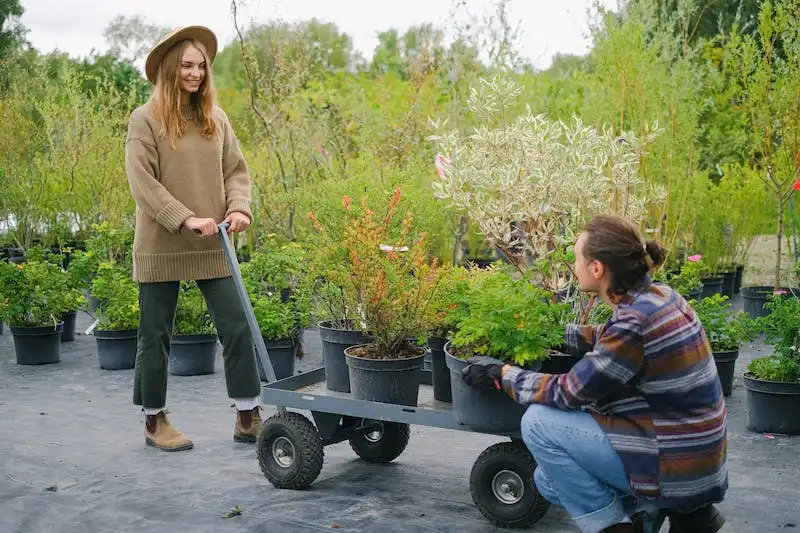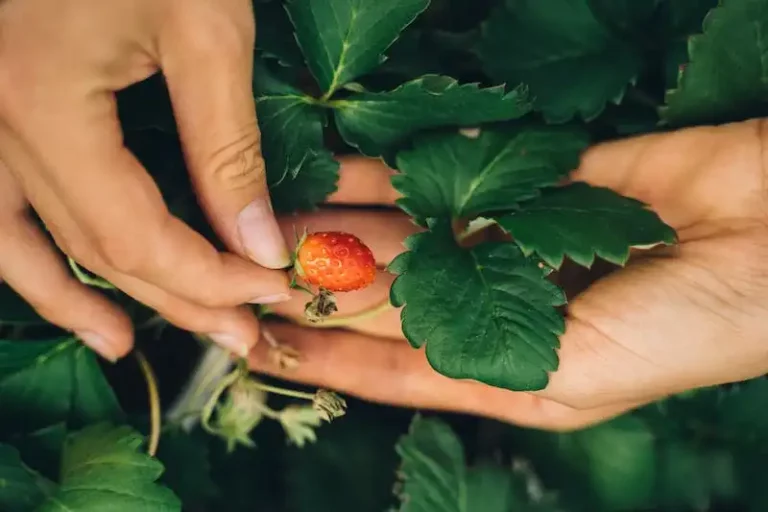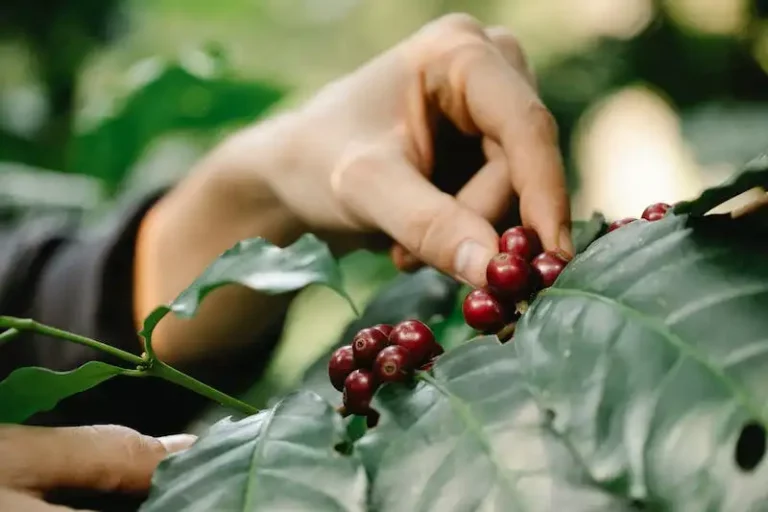The pea plant, or Pisum sativum, is a popular annual plant grown in gardens all around the world. Known for its trailing or climbing stems, the pea plant is well-suited for growing in small spaces and is a common choice for home gardeners. Pea plants can be planted directly in the garden, or started indoors and transplanted once the danger of frost has passed.
One of the main considerations when planting pea plants is the space requirements. Pea plants should be spaced about three inches apart, with rows spaced about two to three feet apart. This allows for proper air circulation and prevents the spread of diseases. Pea plants require support to grow properly, such as a trellis or fence, as their stems can become quite tall and need something to climb on.
To help with germination, it is recommended to soak the pea seeds for a few hours before planting. This softens the seed coat and allows for quicker and more uniform germination. Pea seeds can be planted at a depth of about one to two inches, depending on the size of the seed. Once planted, they should be watered well and kept moist until germination occurs, which typically takes about seven to fourteen days.
Pea plants are ready to be harvested when the pods are well-filled and the peas inside are plump. To harvest, simply grip the stem below the pod and pull gently. If the peas are still too small, you can allow them to continue growing for a few more days. Pea plants can produce multiple harvests if cared for properly, extending the harvest period throughout the growing season.
Once harvested, the peas can be enjoyed immediately or saved for later consumption. Peas can be stored in the refrigerator for up to a week, or blanched and frozen for longer-term storage. Pea plants are a nutritious and versatile food source, offering a good source of vitamins and minerals. Whether you’re a seasoned gardener or a beginner, the pea plant is a great addition to any garden.
Pea Plant
The Pea Plant, or Pisum sativum, is a popular annual plant grown for its edible seeds. Peas are a common garden crop, and they can be grown in both trailing and climbing varieties, depending on the size of your garden and the amount of space you have available.
Peas come in a variety of sizes and colors, ranging from the common green pea to yellow and even purple varieties. They are best harvested when the pods are well-filled and the seeds inside have reached maturity. The pods are typically green, but some varieties may turn brown as they approach maturity.
When planting peas, it is recommended to follow the spacing requirements for the specific variety you’ve selected. Peas should be grown in a sunny spot with well-drained soil. They require a cool growing season, so planting in early spring or late summer is best for most regions.
Peas can be direct sown outdoors or started indoors and transplanted later. Depending on the variety, germination can occur within 7 to 14 days. To help with germination, you can pre-soak the seeds in water for a few hours before planting. It is also important to thin the seedlings to the recommended spacing to ensure good air circulation and prevent overcrowding.
Peas are susceptible to a few pests and diseases, including aphids, powdery mildew, and pea weevils. To control these pests, you can use insecticidal soap or organic sprays. Regularly inspecting your plants for signs of pests or disease can help prevent any damage to your crop.
Peas have a relatively short growing period, usually around 60 to 70 days from planting to harvest. Harvesting is typically done when the pods are fully filled but not completely dried out. You can test the readiness of the peas by gently squeezing a pod; if it feels firm, it is ready for harvest.
After harvest, peas can be eaten fresh, cooked, or used for processing. If you want to save seeds for the next year, select the healthiest and best-looking pea pods for seed-saving. Allow them to dry completely before removing the seeds. Properly stored seeds can remain viable for several years.
In recent years, there has been a growing interest in saving heirloom pea varieties to maintain their genetic diversity and unique characteristics. Many websites and seed-saving organizations offer information and resources to help you get started with saving and exchanging pea seeds.
Overall, growing peas can be a rewarding and enjoyable experience. Whether you’re a seasoned gardener or just starting out, peas are a great addition to any garden. So why not give them a try and enjoy the delicious taste of fresh, homegrown peas!
Recent News
Recently, there has been a lot of news about the benefits of growing pea plants in your garden. Pea plants are easy to grow, and they can be a great addition to any garden. Whether you have a small garden or a large one, there are pea plant varieties that can fit your needs.
One of the recent news is the recommendation of planting and harvesting pea plants in the right size and spacing. This is important as it allows the plants to have enough room to grow and produce well. It also helps in preventing diseases and pests from spreading easily among the plants.
Another recent news is about the importance of saving pea seeds for the next growing season. Proper storage and processing of pea seeds can help maintain their viability and ensure a successful germination rate. It is recommended to harvest pea pods when they are fully matured and dry, and then store the seeds in a cool and dry place.
Furthermore, recent news has highlighted the importance of isolation to maintain the purity of the pea plant population. Isolation helps prevent cross-pollination with other pea varieties, ensuring that the characteristics of the plant remain stable and true to their known traits.
It’s also worth noting that recent news has shown the special considerations for growing different types of pea plants. Trailing peas need support to climb, while climbing peas require trellises or stakes to grow vertically. Additionally, the recent news has recommended thin-skinned pea varieties for easy and hassle-free consumption.
In conclusion, recent news has brought to light various aspects of growing and caring for pea plants. From recommended planting and harvesting practices to storage and germination efforts, there is a wealth of information available to help both new and experienced gardeners get the most out of their pea plant growth.
Grow and Save Pea Seeds
When growing pea plants, it’s not just about the delicious pods you can harvest. You can also save and store the seeds for future planting. Here are some tips for growing and saving pea seeds:
Plant Selection: Choose pea plants that are known for producing good seeds. Look for varieties that have a high germination rate, good pod size, and disease resistance.
Planting Time: Peas are typically planted in the early spring as they prefer cool weather. If you are in a region with a short growing season, consider planting peas as soon as the ground can be worked.
Plant Spacing: Peas can be planted in both rows and blocks. If you are planting in rows, leave a distance of about 3 inches between plants. For block planting, space plants about 6 inches apart.
Climbing or Trailing: Depending on the variety, peas can be either climbing or trailing. Make sure to provide support for climbing varieties, such as trellises or stakes.
Harvesting Peas for Consumption: Harvesting peas for eating is different than saving seeds. Peas intended for consumption are typically harvested when the pods are plump and the peas inside have reached their full size. The pods should be bright green and the peas should be sweet and tender.
Harvesting Pea Seeds: To save pea seeds, allow the pods to mature fully on the plant. The pods will turn dry and brittle, and the peas inside will become hard and starchy. This is the best stage for harvesting seeds.
Seed Processing: To clean the harvested seeds, remove the dry pods and separate the seeds from the chaff. You can do this by gently rubbing the pods between your hands or by using a screen. Make sure to remove any shriveled or damaged seeds.
Seed Viability: Pea seeds usually remain viable for 3-4 years when stored properly. Keep them in a cool, dry place, such as a paper bag or an airtight container.
Special Considerations: When selecting peas for seed saving, consider whether you want to grow the same variety next year. If you do, make sure to save seeds from only one variety and separate it from other varieties to prevent cross-pollination.
Pests and Diseases: Pea plants are generally easy to grow, but they can be susceptible to certain pests and diseases. Keep an eye out for common issues such as powdery mildew or pea aphids. There are many resources available online, such as PlantVillage, that can help you identify and manage these problems.
Recommended Websites: Here are some websites where you can find more information on growing and saving pea seeds: PlantVillage, submitted by a student news article on recent developments in pea plant research.
Final Thoughts: Growing and saving pea seeds can be a rewarding effort. Not only will you have a bountiful harvest of delicious peas to enjoy, but you will also have a steady supply of seeds for future planting.
Time of Planting
When it comes to planting peas, the time of year and the climate play an important role in their growth and harvest. Peas are an annual plant, meaning they complete their life cycle within one year. The best time to plant peas is in the early spring, as soon as the soil can be worked outdoors. They are cold-tolerant plants and can withstand cooler temperatures.
It is recommended to plant peas when the soil temperature reaches around 45 to 75 degrees Fahrenheit (7 to 24 degrees Celsius). Planting too early in colder temperatures can affect the germination stage and viability of the seeds. On the other hand, planting peas too late in the season may result in a shorter growing period, as peas prefer cooler temperatures for optimal growth.
Depending on the variety of peas you’ve selected, there may be different requirements for planting and harvesting. Some popular pea varieties include Pisum sativum, the common pea, and climbing pea plants. These varieties differ in size, climbing ability, and harvesting period.
Before planting, it is essential to prepare the garden bed by cleaning any weeds and loosening the soil. Peas grow best in well-drained soil, so it is recommended to add compost or organic matter to improve the soil’s fertility. Plant the pea seeds about two inches deep and three inches apart, allowing enough space for the plants to grow.
After planting, peas usually take about seven to fourteen days to germinate. During this time, it is essential to keep the soil moist but not waterlogged. Peas have shallow root systems, so regular watering is necessary, especially during dry periods. It is also recommended to provide support for climbing pea plants by installing trellises or stakes to help the stems grow upwards.
Harvesting time for peas varies depending on the variety and personal preference. Peas can be harvested at any stage, from the edible pea shoots to the fully mature pods. For fresh eating, peas are typically harvested when the pods are firm and plump. The peas should feel full and round inside the pods. When harvesting for seed saving or processing, it is recommended to wait until the pods turn brown and dry on the plant. This indicates that the peas are fully mature and have reached their maximum size and seed viability.
After harvesting, it is important to store peas properly to maintain their quality and freshness. Peas can be stored in the refrigerator for up to a week, or they can be blanched and frozen for longer storage. Proper cleaning and removing any damaged or rotten peas are necessary before storing. Storing peas in a cool and dry place, away from direct sunlight, is recommended to prevent spoilage.
When it comes to assessing the success of your pea planting effort, there are some considerations to keep in mind. Peas are susceptible to certain pests and diseases, so it is important to monitor the plants for any signs of trouble. Common pests include aphids, pea weevils, and root knot nematodes, while common diseases include powdery mildew and root rot. Regular inspection and using preventive measures, such as crop rotation and proper garden hygiene, can help prevent these issues.
In conclusion, planting peas at the right time and providing the necessary care can result in a successful harvest. Whether grown for fresh consumption or seed saving, peas are a popular garden choice due to their delicious taste and nutritional value. By following the recommended planting guidelines and considering the specific requirements of the pea variety, you can enjoy a bountiful pea harvest in your garden.




